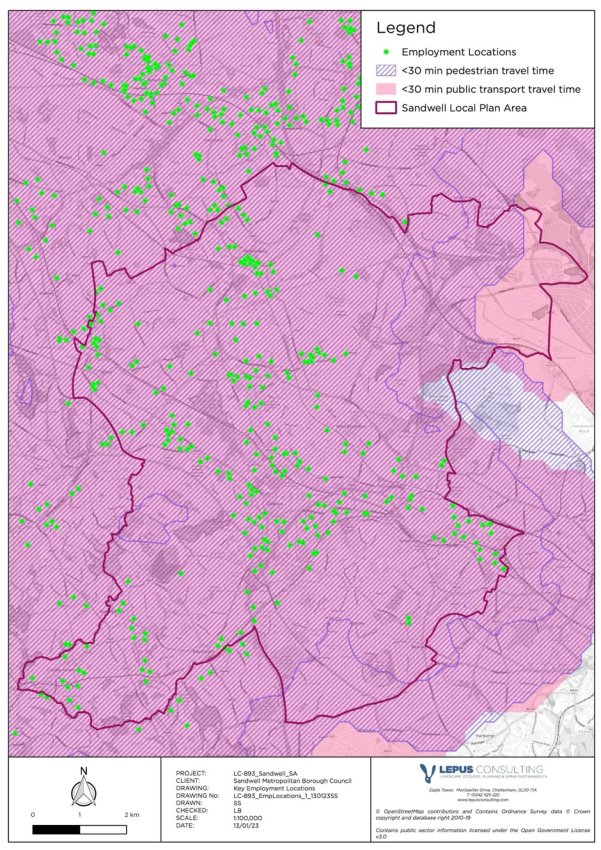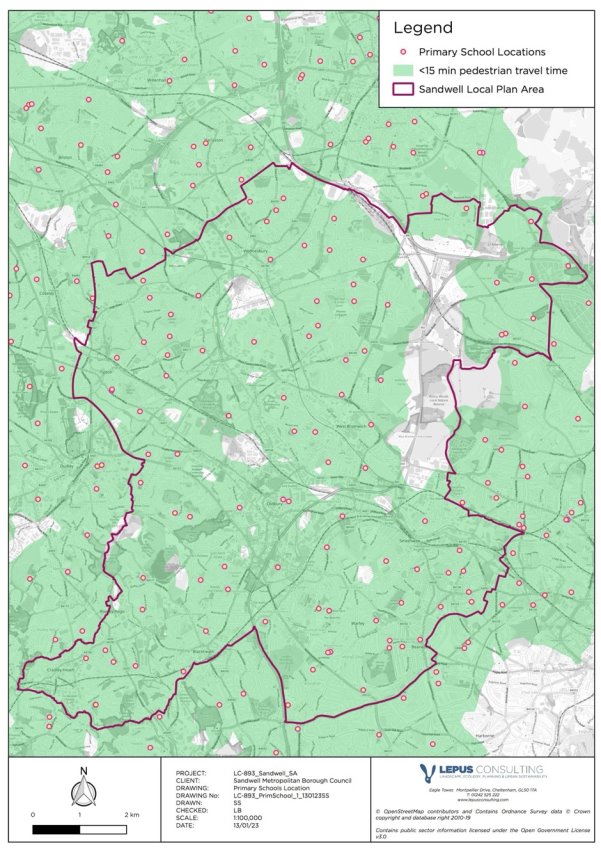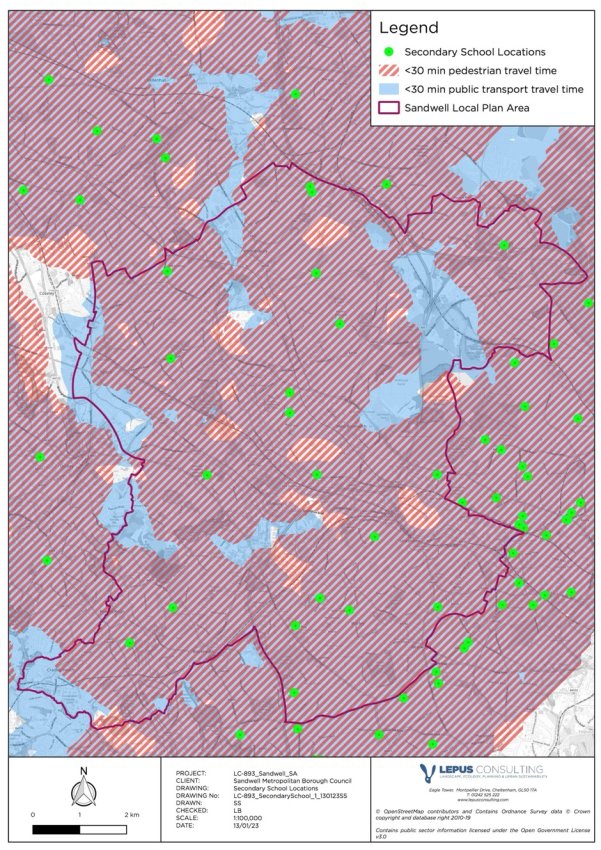Sustainability Appraisal of the Sandwell Local Plan 2024-2041
13 Population and material assets
13.1 Introduction
13.1.1 The consideration of 'Population' is a broad matter and includes topics such as pollution and waste, housing, transport and accessibility, education, economy and employment. The population topic seeks to create places where residents live a high quality of life for longer, are well educated and have the necessary skills to gain employment and succeed in modern society. Indicators of these objectives include the proximity of development proposals to schools, accessibility to employment land and proximity to services and amenities.
13.1.2 PPPs on population cover a range of different objectives, including tackling social exclusion and inequalities, improving health, improving housing quality, and reducing levels of education failure, ill health, substance misuse, crime and anti-social behaviour. At the regional and local levels, support for cultural diversity and young people are key aims.
13.1.3 'Material assets' covers a variety of built and natural assets which are accounted for in a range of topics. It is a requirement of Schedule 2 of the SEA Regulations to consider material assets, although the Regulations does not define them. The SA process considers material assets as the social, physical and environmental infrastructure implications of the local plan.
13.1.4 The material assets sustainability theme covers a range of policy areas, including waste management, minerals, energy production and previously developed land. PPPs seek to protect mineral resources and promote appropriate after uses for mineral workings, and promote the 'waste hierarchy'.
13.2 Baseline and key issues
Population
13.2.1 Sandwell has a population of 341,900 according to the latest Census (2021)[107]. Population size has increased by 11.0%, from around 308,100 in 2011 to 341,900 in 2021. This is higher than the overall increase for England (6.6%), where the population grew by nearly 3.5 million to 56,489,800.
13.2.2 The borough's population is predicted to grow at a faster rate than both the population of the West Midlands and the national average and is forecast to increase by 30,000 between 2016 and 2030. On average, Sandwell has a higher proportion of the population aged under 20, and a lower proportion aged over 50, than the average for the rest of the UK[108].
Equality and diversity
13.2.3 Sandwell is a diverse area, with individuals from a range of ethnic backgrounds, religions and cultures. In 2021, 57.3% (195,620) of usual residents in Sandwell identified their ethnic group within the high-level 'White' category, compared with 81.7% in England & Wales[109].
13.2.4 The Index of Multiple Deprivation (IMD) measures the relative levels of deprivation in 32,844 Lower Super Output Areas (LSOAs) in England[110]. LSOAs are small areas designed to be of similar population, of approximately 1,500 residents or 650 households. Out of 317 Local Authorities in England, Sandwell is ranked as the 12th most deprived. Overall, deprivation is high across the SLP area, with 36 LSOAs in Sandwell ranked among the 10% most deprived in England.
Housing
13.2.5 Government guidance requires local authorities to determine the local housing need figure for their area. The local plan preparation process should then test the deliverability of this housing need figure. The local housing need figure is calculated by summing the national standard method figure, using 2014-based ONS household projections and affordability ratios which are updated annually.
13.2.6 SMBC have produced a Strategic Housing Land Availability Assessment (SHLAA)[111], which is updated annually, to assess land with potential for development in order to inform the housing land supply and trajectory.
13.2.7 Any identified options for the quantum of housing growth, as well as reasonable alternative sites for development, will be assessed as part of the SA process.
Economy
13.2.8 Sandwell Borough is multi-centric, with a Strategic Centre (West Bromwich), seven other main town centres and several smaller local centres serving the population. The highest density of employment locations can be found in the centre and north of the SLP area and along the key transport routes. Accessibility modelling data[112] indicates that the majority of Sandwell lies within a 30-minute travel time to an employment site, either via walking or public transport (see Figure 9.1).
13.2.9 The proportion of unemployed adults in Sandwell is 6%, which is higher than the average for West Midlands (4.9%) and for Great Britain (3.8%)[113]. Sandwell has a high proportion of workers in the manufacturing and wholesale and retail trade industries, with fewer employees in financial, IT and professional occupations than the average for the West Midlands and Great Britain.
13.2.10 Sandwell lies within the Black Country Functional Economic Market Area (FEMA) which also covers the local authorities of Dudley, Walsall and Wolverhampton. The Black Country Economic Development Needs Assessment (EDNA)[114] sets out the identified employment land requirements within Sandwell of 185ha. Identified options for the quantum of employment growth, as well as reasonable alternative sites for development, has been assessed as part of the SA process.
Education, skills and training
13.2.11 20 secondary schools and 98 primary schools can be found within Sandwell. It is assumed that new residents in the SLP area will require access to primary and secondary education to help facilitate good levels of education, skills and qualifications of residents. Accessibility modelling data[115] indicates generally good levels of sustainable accessibility to schools across the SLP area although some gaps are identified (see Figures 9.2 and 9.3).
13.2.12 Further and higher education opportunities in Sandwell and nearby areas include Sandwell College, University of Wolverhampton and Dudley College of Technology. Within the wider West Midlands, there are several universities including the University of Birmingham, Birmingham City University and Aston University.
13.2.13 Sandwell's residents have on average lower qualification levels compared to the West Midlands and Great Britain[116].

Figure 13.1: Key employment Locations and modelled travel time across the SLP area (source: SMBC)

Figure 13.2: Location of primary schools and modelled travel time across the SLP area (source: SMBC)

Figure 13.3: Location of secondary schools and modelled travel time across the SLP area (source: SMBC)
Waste
13.2.14 The proposed development within the SLP area and associated increase in residents would be expected to result in a significant increase in waste produced. It is assumed that new residents will have an annual waste production in line with the national average, which was 477kg per person in 2022[117].
13.2.15 The proportion of local authority collected waste in the West Midlands sent for recycling and composting is below the national levels, whereas the waste managed through incineration is higher than national levels.
13.2.16 Although national trends suggest that the volume of household waste produced is decreasing, the Black Country Waste Study[118] indicates that additional capacity for certain types of waste management will be required, taking into account the large amount of projected growth in the area as well as continuing to facilitate the import of waste from other neighbouring authorities.
Minerals
13.2.17 The presence of mineral resources, in particular coal, was a key reason for the original prosperity and development of the Black Country region. The legacy of mineral extraction on ground stability and contamination remains a key issue affecting future development, and some minerals are still of economic importance with active quarries and brickworks.
13.2.18 There is a need for a balanced approach between safeguarding mineral resources and supporting housing and economic growth. The protection and extraction of mineral resources is important to help support the levels of development proposed over the Plan period and to meet demand for aggregates. There are no Mineral Safeguarding Areas within Sandwell, although there are various mineral infrastructure sites including brickworks, concrete plants and aggregate recycling facilities present within the SLP area[119].
Key issues for population and material assets include:
- Sandwell's residents have on average lower qualification levels and employment rates compared to the West Midlands and Great Britain.
- There is a need to increase the proportion of waste sent for reuse, recycling or composting and move away from the use of landfill for waste disposal.
- Sandwell is ranked as the 12th most deprived local authority in England. There is a need to support strong, vibrant and healthy communities by:
- Providing the supply of housing required to meet the needs of present and future generations;
- Creating a high-quality built environment, with accessible local services that reflect the community's needs and support health, social and cultural wellbeing;
- Creating a strong sense of place by strengthening the distinctive and cultural qualities of towns and villages; and
- Creating safe and accessible environments where crime, disorder and the fear of crime do not undermine quality of life or community cohesion.
- Due to Sandwell's demography and urban structure, the population was hit hard by the COVID-19 pandemic, most notably its central corridor of older, poor-quality housing and communities from ethnic minority backgrounds, where infection rates were highest. The pandemic has deepened hardship and inequality in the already deprived area, with high reliance on Universal Credit, increased mental health issues and educational disruption.
13.3 Impacts on population and material assets
13.3.1 Box 13.1 presents a plan-wide summary of the adverse impacts on population and material assets that have been identified through the SA process. These adverse impacts are those identified prior to mitigation considerations.
Box 13.1: Summary of identified impacts on population and material assets
Impact on population and material assets
Summary of identified impact

Provision of housing to meet local need
The SLP proposes the development of 10,434 dwellings across the Plan period to 2041. This is expected to meet a large proportion of the identified housing need, with the remainder being met through other forms of housing provision such as through windfall developments and export to neighbouring local authorities via the Duty to Co-operate. The degree to which residents from vulnerable groups, such as those on low incomes and the elderly, will benefit from the increased housing provision will be dependent upon the size, type and tenure of housing provided.

Provision of employment opportunities
The SLP allocates 1,221ha of employment floorspace (of which 28ha is currently vacant). The Plan will be likely to have a positive impact on the local economy, as well as the wellbeing of residents. The proposals in the SLP are expected to satisfy the identified requirements for the borough in line with the latest evidenced needs.

Sustainable access to services and facilities
A small number of site allocations are situated outside of sustainable distances to essential services, including public transport options, and beyond the recommended sustainable travel times to schools, local services and employment opportunities. Good access to these services is essential to reduce reliance on private car use, encourage healthy and active lifestyles and provide accessibility to spaces which could potentially have benefits to mental wellbeing and community cohesion.
Of the 69 sites allocated for residential or mixed-use development, the majority will have sustainable access to a primary school, however, site SH17 lies outside the 15-minute sustainable distance on foot for access to a primary school, nine sites lie outside a 25-minute walk and five sites lie outside the 25-minute journey via public transport to a secondary school.
The majority of sites are anticipated to be situated within a 15-minute journey to a local store to meet day-to-day food needs, however, 25 sites lie outside the 15-minute sustainable distance to access local services by foot and site SEC3-193 lies outside the 15-minute sustainable distance to local services by public transport.
All residential-led site allocations lie within a 30-minute public transport journey to employment opportunities, however site SH43 is located over a 30-minute sustainable distance on foot to employment opportunities.
Some three sites including SH18, SH35 and SH36 are located over 400m from a bus stop providing regular services, and two sites including SH37 and SH42 are located over 2km from a railway or metro station.
Sustainable access to healthcare services is considered under Chapter 11: Human Health.

Increased pressure on local services and facilities
The proposed development within the SLP is expected to increase population density across Sandwell. This will be likely to apply greater pressures on the capacity of services within the Plan area, including schools, GP surgeries, leisure centres and open spaces.

Addressing inequalities
All residents should be provided with equal access to a range of opportunities, to support the local population in living happy and healthy lifestyles. Fostering interactive and vibrant communities often benefit from a strong sense of place, a reduced fear of crime and a strong local economy.
A total of 38 allocations are situated within the top 10% most deprived Lower layer Super Output Areas (LSOAs); introducing new development into these areas has potential to exacerbate existing inequalities within Sandwell.
On the other hand, the proposed new development and regeneration opportunities within the SLP will be likely to have a positive effect with regard to establishing and maintaining cohesive communities and improving equality, through seeking to provide a range of housing, employment opportunities and supporting infrastructure to meet the varied needs of the local population.

Increased household waste generation
SMBC has responsibility for the provision of waste collection and recycling services for households as part of the management of waste. The proposed development of 10,434 new dwellings within the SLP is expected to increase household waste generation, and have a potential adverse effect on the capacity of waste management facilities within the Plan area.
13.4 Local Plan mitigation
13.4.1 Many of the SLP policies are expected to have positive residual effects in relation to population, in particular for housing and employment floorspace provision. The spatial strategy for development in Sandwell to 2041 directs the majority of new development towards existing urban areas, in line with the provision of services and facilities. The policies which help mitigate adverse effects on population and material assets are discussed in Box 13.2.
Box 13.2: Mitigating effects of the Local Plan policies on population and material assets
Policy mitigation for population and material assets
Summary of mitigating effect

Provision of housing to meet local need
Policy SHO1: Delivering sustainable housing growth and Policy SDS1: Spatial Strategy for Sandwell supports the delivery of 10,434 homes in order to contribute to meeting the identified housing need which provide a range of choice of new homes, whilst setting out locations of housing land supply including for potential windfall developments as set out in Policy SHO2: Windfall developments.
Policy SHO3: Housing density, type and accessibility seeks to provide a "range of types and sizes of accommodation" in order to create "mixed, sustainable and inclusive communities", which is supported by Policy SHO4: Affordable housing which aims to provide a proportion of affordable homes on developments of ten or more residences.
Other policies such as Policy SHO5: Delivering accessible and self / custom build housing, Policy SHO6: Protecting family housing (Use Class C3) and Policy SHO7: Houses in multiple occupation set out a variety of regulations to ensure housing standards meet the needs of occupants.
Policy SHO9: Accommodation for Gyspies, Travellers and Travelling Showpeople seeks to protect existing Gyspy, Traveller and Travelling Showpeople sites and ensures a sufficient number of pitches are allocated to meet the identified need.
Provision of employment opportunities
Policy SDS1: Spatial Strategy for Sandwell aims to provide 1,221ha of employment land throughout the Plan period, which also includes measures to retain existing employment areas.
Policy SDS3: Regeneration in Sandwell states that the defined Regeneration Areas will provide high-quality employment land and will be the principal location for new industrial/logistics development, with likely benefits in terms of economic growth and providing opportunities for developing a skilled workforce.
Policy SEC1: Providing for economic growth and jobs also supports the renewal and regeneration of existing employment areas and sets out the provision of employment land to be delivered. This is supported by Policy SDM9: Community facilities which ensures any proposals for community facilities will not be permitted should it involve the loss of premises or sites located within a strategic or local employment area.
Policy SEC2: Strategic Employment Areas ensures these spaces will be defined primarily by commercial uses, businesses and services with "excellent accessibility". Alongside this, Policy SEC3: Local Employment Areas characterises these spaces as being predominantly having industrial, warehouse or services in accessible locations for local markets and employees. Policy SEC4: Other Employment Sites supports this by providing new industrial employment or extensions to existing industrial employment uses.
Policy SEC5: Improving access to the labour market supports major developments for new jobs that will be readily available for residents of Sandwell, specifically those living in the most deprived areas.
Policies SDM1: Design Quality, STR1: Priorities for the development of the transport network, STR2: Safeguarding the development of the KRN, STR3: Managing transport impacts of new development and STR5: Creating coherent networks for cycling and walking ensure that residents have sustainable access to employment opportunities through well-designed places and strong transport infrastructure.
Policies SID2: Digital infrastructure and SDM10: Telecommunications will aim to improve access to employment opportunities, including home working, through the provision of a strong fibre network and telecommunications infrastructure.
Sustainable access to services and facilities
Policy STR1: Priorities for the development of the transport network states that "all new developments must provide adequate access for all modes of travel, including walking, cycling and public transport". The policy also identifies the "Midlands Rail Hub" and "West Midlands Core Bus Network corridors" as key transport priorities, amongst others.
Policy STR2: Safeguarding the development of the Key Route Network (KRN) seeks to ensure the KRN is effectively managed in order to support the level of growth proposed in the SLP over the Plan period, and could potentially encourage coordination and streamlining of transport systems including public transport such as rapid transit and bus routes.
By directing development towards the Strategic Centre (West Bromwich) and the hierarchy of Town, District and Local Centres, Policy SDS1: Spatial Strategy for Sandwell will be likely to facilitate more sustainable communities, by locating residents in close proximity to services, facilities and public transport.
Policy SDS3: Regeneration in Sandwell highlights a number of transport infrastructure projects which will help to improve access to sustainable travel options, including the new Midland Metro Extension and Dudley Port railway station. Improvements to public transport connectivity / interchanges within regeneration areas and linking to these wider projects will be supported.
Various SLP policies including Policies STR3: Managing transport impacts of new development, STR5: Creating coherent networks for cycling and walking, STR6: Influencing the demand for travel and travel choices, SHW2: Healthcare infrastructure, SHW3: Air quality and SDS5: Achieving well-designed places include measures that aim to improve accessibility to bus services, rail infrastructure, active travel routes and local services.
Sandwell's Centres Policies SCE1-SCE6 support appropriate uses within centres to meet day to day needs of residents and visitors to these areas, in accordance with the settlement hierarchy, including Policy SCE5: Provision of Small-scale local facilities not in centres which supports the provision of new small-scale local facilities outside of centres.
Policy SHO8: Education facilities supports the development or expansion of education facilities and states that nurseries, schools and higher education facilities should be "well- served by public transport infrastructure".
Increased pressure on local services and facilities
Policy SDS1: Spatial Strategy for Sandwell is likely to facilitate more sustainable communities, where residents are located in close proximity to an expanded number of services, facilities and means of public transport.
Sandwell's Centres Policies SCE1-SCE6 support appropriate uses within centres to meet day to day needs of residents and visitors to these areas to improve the distribution and capacity of local facilities, supported by Policy SCE5: Provision of Small-scale local facilities not in centres which supports the provision of new small-scale local facilities outside of centres.
Policy SDM9: Community facilities supports the retention of, and development of new, community facilities.
Policy SHO8: Education facilities supports the development or expansion of education facilities and states that nurseries, schools and higher education facilities should be "well- designed" to increase the quality and capacity of educational facilities.
Addressing inequalities
Policies SDS1: Spatial Strategy for Sandwell, SDS5: Achieving well-designed places, SCE5: Provision of small-scale local facilities not in centres, SDS3: Regeneration in Sandwell, SEC5: Improving access to the labour market and SID1: Infrastructure provision and viability assessments include measures that will ensure residents have access to local services, including employment opportunities, various public transport methods, shops, educational facilities, leisure and sport facilities and public open space, including for those living in the most deprived areas.
Policy SDM9: Community facilities sets out support for new community facilities within centres, and will ensure that any security and crime issues associated with new community developments are identified and addressed. This has the potential to reduce crime and social deprivation.
Policies SHO8: Education facilities and SHW2: Healthcare infrastructure state that educational and healthcare facilities should be "located to address accessibility gaps" which will help to reduce health inequalities and improve equal access to educational opportunities.
Policy SHW5: Playing fields and sports facilities states that playing fields and sports facilities "will be encouraged, especially in areas where public provision is deficient".
Policies SHO3: Housing density, type and accessibility, SHO4: Affordable housing and SHO10: Housing for people with specific needs aim to ensure that the Plan delivers an appropriate density and mix of housing, well-distributed affordable housing provision and for housing to meet the varied needs of current and future residents in Sandwell.
Policy SHO5: Delivering accessible and self/custom build housing seeks to ensure an appropriate mix of accessible and adaptable homes are delivered across the Plan area, as well as the opportunity for self-build homes, in line with national policy and the Building Regulations.
Policy SHO9: Accommodation for Gypsies, Travellers and Travelling Showpeople will ensure the SLP meets the identified pitch targets for Gypsies and Travellers and plot targets for Travelling Showpeople, as set out in the latest Gypsy and Traveller Accommodation Assessment (GTTA).
Increased household waste generation
Policy SWA1: Waste infrastructure future requirements sets out the waste infrastructure requirements to be adhered to throughout the borough, seeking to reduce the generation of waste and associated pollution, promote re-use and recycling of waste in line with the waste hierarchy. The policy ensures the "minimisation of waste production and the re-use and recovery of waste materials" by providing sufficient waste facilities.
Policy SWA5: Resource management and new development requires all new developments to "minimise waste as far as possible" and seeks to maximise the use of "secondary and recycled materials, renewable and locally sourced products and materials with low environmental impacts" wherever possible. The policy will help to promote sustainable and efficient waste management and use of materials across all new development in Sandwell and limit the generation of waste as much as is feasible.
Policy SCC4: Embodied carbon and waste encourages building design to facilitate the re-use of and easy disassembly of materials which would contribute to reducing the need for demolitions when buildings are no longer required, reducing the quantity of waste produced in the construction and demolition of the proposed development.
Policy SEC3: Local Employment Areas seeks to safeguard areas for "waste collection, transfer and recycling uses", supporting the efficient management and disposal of waste.
Policy SID1: Infrastructure provision and viability assessments sets out the overarching requirement for the provision of new infrastructure to support new development proposed in the Sandwell area, which is expected to include utilities such as waste and recycling.
Policies SWA2: Waste sites, SWA3: Preferred areas for new waste facilities and SWA4: Locational considerations for new waste facilities set out measures to ensure waste facilities meet the demand of the borough in regard to capacity. These make sure waste facilities are sustainable by nature/design, whilst being strategically located in suitable locations.
13.5 Residual effects on population and material assets
13.5.1 Many of the policies would be expected to have positive residual effects in relation to population, in particular for housing and employment floorspace provision. A residual adverse effect in relation to material assets would be likely to be the expected increase in household waste generation over the Plan period. Residual effects in relation to population and material assets are discussed further in Box 13.3.
Box 13.3: Residual effects for population and material assets
Residual effects
Further details of the residual effect
Provision of housing to meet local need
In order to meet the identified housing need, the SLP proposes to deliver at least 10,434 new dwellings. Policies in the Plan set out the requirements to provide an appropriate mix of housing types and tenures, and seek to meet the needs of different groups including the provision of accessible and adaptable dwellings, in line with the Building Regulations. The Plan also seeks to deliver sites sufficient to meet the needs of Gypsies, Travellers and Travelling Showpeople, as set out in the Black Country GTAA[120]
The Plan aims to deliver the identified housing need, therefore a positive residual effect on housing is anticipated.
Provision of employment opportunities
The Plan allocates 1,221ha of employment land, seeking to meet the need identified in the latest EDNA[121]. A total of 36 proposed allocations for employment or mixed-use development are anticipated to provide a range of jobs for new and existing residents, and will locate new residents within sustainable distances of employment opportunities or provide sustainable transport choices to access employment opportunities. A positive residual effect on employment provision is anticipated.
Sustainable access to local services and facilities
Policies within the SLP are anticipated to help improve residents' accessibility via sustainable transport options, including improvements to the rail and bus network and enhanced pedestrian and cycle networks. Access to local services is also likely to improve for the majority of sites, as well as ensuring all residents are located within a sustainable distance to educational facilities and employment areas. A positive residual effect is expected for sustainable access to local services and facilities.
Increased pressure on local services and facilities
A number of SLP policies support the expansion of local services and facilities both within and outside of town centres, including the development of new community facilities. Educational opportunities will also be improved and compensated for such as through increasing the capacity of local schools. These policies will promote the development of high-quality facilities in Sandwell with sufficient capacities, therefore a negligible effect will be anticipated for increased pressure on local services and facilities overall.
Addressing inequalities
The SLP policies demonstrate SMBC's commitment to enhancing community cohesion and improving inequalities by addressing the diverse accommodation needs of the population, safeguarding community services and facilities, and encouraging development proposals to incorporate careful design which delivers a high-quality public realm. These proposals aim to help residents feel safe and improve equal access to opportunities, whilst giving potential for rejuvenation within deprived areas.
The impact of this broad range of policy interventions is anticipated to improve community cohesion through improving opportunities for social interaction, sense of place and reducing social inequalities. A positive residual effect on equality is anticipated.
Increased household waste generation
The SLP sets out a policy framework for the sustainable management of waste, seeking to ensure sufficient capacity in waste management infrastructure over the Plan period, and promoting the reduction, re-use and recycling of waste in line with the waste hierarchy.
It is difficult for the SLP to specifically reduce waste generation within the Plan area. Although national trend data indicates a general decrease in household waste generation over time, the introduction of 10,434 new households is expected to increase waste production to some extent and potentially impact the capacity of these facilities.
The impact of increased waste generation on the capacity of waste management facilities could potentially be a long-term albeit potentially temporary significant effect.
[107] Office for National Statistics (2022) How the population changed in Sandwell: Census 2021. Available at: https://www.ons.gov.uk/visualisations/censuspopulationchange/E08000028/ [Date accessed: 08/07/24]
[108] Sandwell Trends (2022) 2021 Census: Overview. Available at: https://www.sandwelltrends.info/2021-census/#:~:text=Ethnic%20Group%20%26%20Language,69.9%25%20in%20the%202011%20Census. [Date accessed: 08/07/24]
[109] Sandwell Trends (2022) 2021 Census: Overview. Available at: https://www.sandwelltrends.info/2021-census/#:~:text=Ethnic%20Group%20%26%20Language,69.9%25%20in%20the%202011%20Census. [Date accessed: 08/07/24]
[110] MHCLG (2019) The English Indices of Deprivation 2019. Available at: https://assets.publishing.service.gov.uk/government/uploads/system/uploads/attachment_data/file/835115/IoD2019_Statistical_Release.pdf [Date accessed: 08/07/24]
[111]Sandwell Strategic Housing Land Availability Assessment (SHLAA) (April 2023) Available at: https://www.sandwell.gov.uk/downloads/file/2616/sandwell-shlaa-2023 [Date accessed: 08/07/24]
[112] Unpublished data provided to Lepus by the Council
[113] Nomis (2021) Labour Market Profile – Sandwell. Available at: https://www.nomisweb.co.uk/reports/lmp/la/1946157189/report.aspx [Date accessed: 08/07/24]
[114] WECD (2023) Black Country Authorities Employment Land Needs Assessment 2020 to 2041. Available at: https://www.sandwell.gov.uk/downloads/file/1546/black-county-authorities-employment-land-needs-assessment-2020-2041-august-2023- [Date accessed: 21/08/24]
[115] Unpublished data provided to Lepus by the Council
[116] Nomis (2021) Labour Market Profile – Sandwell. Available at: https://www.nomisweb.co.uk/reports/lmp/la/1946157189/report.aspx [Date accessed: 08/07/24]
[117] DEFRA (2021) Statistics on waste managed by local authorities in England in 2022/23. Available at: https://www.gov.uk/government/statistics/local-authority-collected-waste-management-annual-results/local-authority-collected-waste-management-annual-results-202223#:~:text=In%202022%2F23%2C%20total%20local,per%20cent%20from%202021%2F22 [Date accessed: 08/07/24]
[118]WSP (2023) Black Country Waste Study. Available at: https://www.sandwell.gov.uk/downloads/file/1501/bca-waste-study-update-september-2023- [Date accessed: 08/07/24]
[119] WSP (2023) Black Country Minerals Study Update. Available at: https://www.sandwell.gov.uk/downloads/file/1719/bc-minerals-study-update-2023-sandwell [Date accessed: 08/07/24]
[120] RRR Consultancy (2022) Black Country GTAA. Available at: https://www.sandwell.gov.uk/downloads/file/1558/black-country-gtaa-april-2022- [Date accessed: 21/08/24]
[121] WECD (2023) Black Country Authorities Employment Land Needs Assessment 2020 to 2041. Available at: https://www.sandwell.gov.uk/downloads/file/1546/black-county-authorities-employment-land-needs-assessment-2020-2041-august-2023- [Date accessed: 21/08/24]
